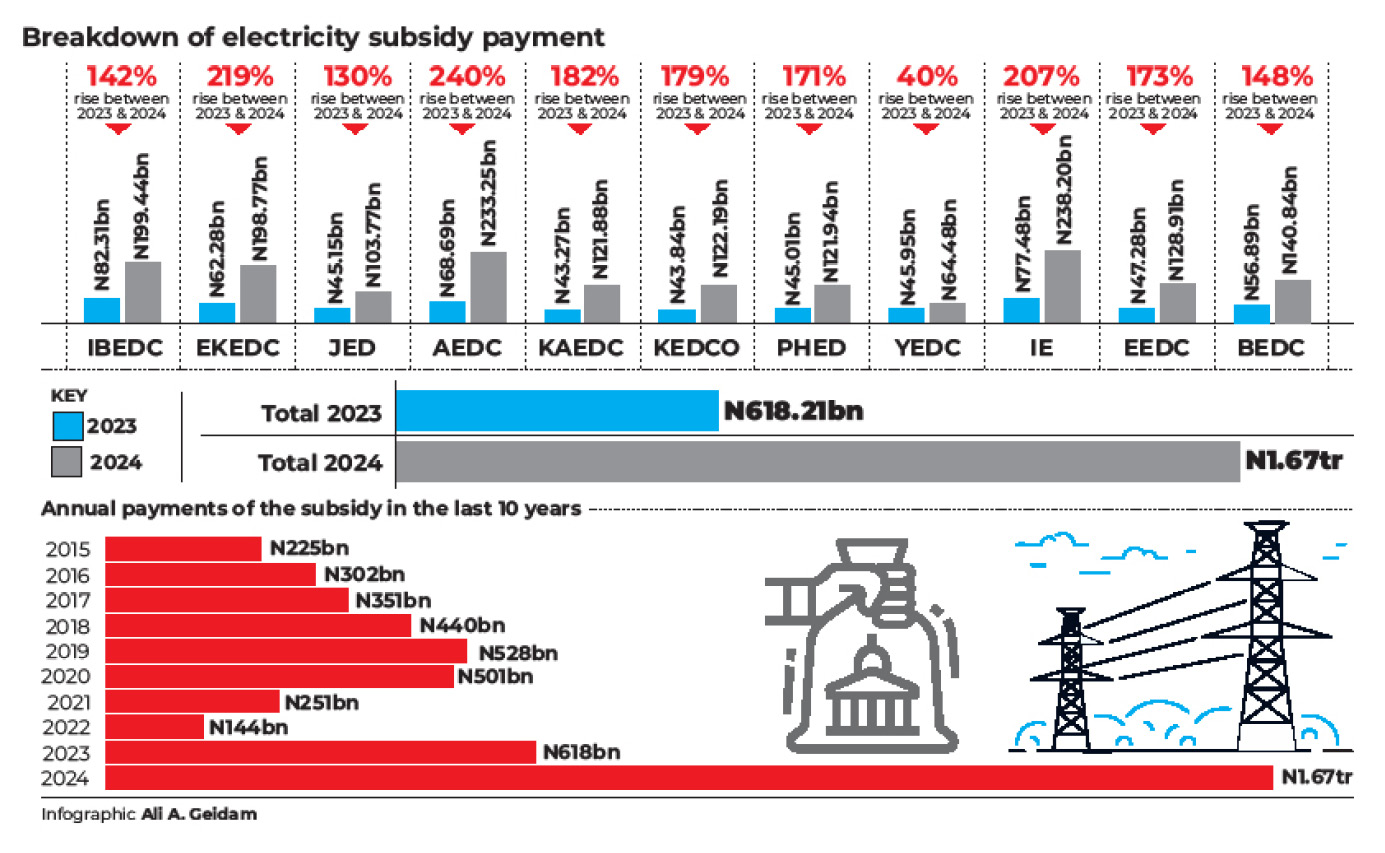The federal government’s effort to subsidise electricity tariff for Nigerians has seen it cough out over N5 trillion in the last 10 years amounting to over 664 per cent growth, data from the Nigerian Electricity Regulatory Commission (NERC) has shown.
The data also revealed that the amount the government paid from 2015 to 2024 had a spike of 171 per cent from what it would pay the 11 Electricity Distribution Companies (DisCos) from 2023 to 2024.
A breakdown of the data showed that the government paid N225bn in 2015, which increased to N302bn in 2016. In 2017 it went up to N351bn, N440bn in 2018 and N528bn in 2019
While the subsidy came down in 2020 to N501bn, the introduction of Multi Year Tariff Order (MYTO) by the government reduced the subsidy in 2021 to N251bn.
- 16 passengers die in Zaria-Kano highway crash
- 21st Daily Trust Dialogue: Edun, Ajaero, others to analyse Tinubu’s reforms Thursday
Daily Trust reports that MYTO is an order by NERC that allows the review of electricity tariff twice a year for a near cost reflective tariff.
The order also made the tariff to fall to N144bn in 2022, but the rising inflation and the devaluation of the dollar in 2023 pushed the subsidy up to N618bn.
The government said while the tariff cost was increased, consumers were made to pay the old price while it took the bills for the new charges that were occasioned by the economic headwind the country was facing.
With experts projecting Nigeria’s economy will go for the worse in 2024 before any succour can be felt later in the year, the government stated that it would pay N1.673trn during the year while electricity consumers continued to pay the old price.
The continuance of the subsidy is despite the NERC in its 2022 Market Competition Report stating that rich customers constituted the highest consumers of electricity in the country, thus enjoying more of the subsidy provided in the sector.
The report noted that end-user tariff subsidy in Nigeria was pro-rich as the top income group consumed more electricity than the low income group, thereby benefiting more from subsidy than the lower income earners.
Ikeja DisCo to get highest payment in 2024
Further analysis on what each DisCo will get as subsidy payment in 2024 indicated that the Ikeja Electricity (IE) will get the highest payment, followed by the Abuja Electricity Distribution Company (AEDC). Conversely, the Yola Electricity Distribution Company (YEDC) will get the lowest payment, followed by the Jos Electricity Distribution Company (JEDCO).
A breakdown showed that the IE will be paid N238.2bn in 2024, an increase of 207 per cent from the N77.4bn it was paid in 2023. This is followed by the AEDC which will receive N233.2bn, a 240 per cent increase from the N68.6bn it received in 2023. Ibadan Electricity Distribution Company (IBEDC) comes next with N199.4bn from the N82.3bn it collected in 2023, an increase of 142 per cent.
Eko Electricity Distribution Company (EKEDC) is to receive N198.7bn, an increase of 219 per cent from the N62.2bn it collected in 2023, while Benin Electricity Distribution Company (BEDC) will be credited with N140.8bn from the N56.8bn it was given in 2023, an increase of 148 per cent.
Enugu Electricity Distribution Company (EEDC) is next with N128.9bn, an increase of 173 per cent from the N47.2bn it collected in 2023, with Kano Electricity Distribution Company (KEDCO) getting N122.bn from the N198bn it received in 2023, a 179 per cent increase.
Port Harcourt Electricity Distribution Company (PHED) will get N121.9bn, a 171 per cent rise from the N45bn it was given in 2023, while Kaduna Electricity Distribution Company (KAEDC) is to be given 121.8bn, a 182 per cent rise from the 43.2bn it received in 2023.
This is followed by JEDCO which will receive N103.7bn, an increase of 130 per cent from the N45.1bn it collected in 2023, while YEDC will get N64.4bn, a 40 per cent increase from the N45.9bn it collected in 2023.
With the economic situation in the country volatile, Daily Trust reports that the subsidy may increase or decrease as the new MYTO will see a monthly review of the tariff depending on the prevailing economic situation.
Subsidy detrimental to government finances – Expert
Speaking with Daily Trust, the convener and Executive Director of PowerUp Nigeria, Adetayo Adegbemle, said the continued payment was detrimental to government finances, urging it to take a quick decision before the situation spiralled out of control like the petrol subsidy.
He explained that this was because electricity subsidy was not sustainable and that Nigeria needed to start thinking of where else the subsidy paid in could be better applied.
He recalled that the government in 2020, with the introduction of Service-Based Tariff, decided to phase out subsidy on electricity tariff because of the strain it’s putting on government finances and the inefficiencies it promoted in the energy sector.
He said, “This was necessitated by the fact that payment of subsidies, both on petrol and electricity, had become an albatross on government finances. Between 2015 and 2020, the shortfall in tariff reportedly stood at about N2.4trn, averaging N200bn yearly, and in 2022 alone, over N600bn was paid in subsidies, and it has been estimated to skyrocket to at least N1trn in 2024. The question now is, with the present state of government finances, is payment of subsidy on electricity tariff sustainable?”
He also explained that the 2022 MYTO was made to gradually phase out subsidy so that Nigerians could start paying Cost Reflective Tariff, stating that the rationale was on the fact that DisCos that were in highly urban centres were allowed to charge tariffs that were near cost reflective due to evidence of high purchasing power and high consumption level in those areas, while DisCos that were in areas with low-income consumers were allowed to charge lower allowed tariff, thereby paying higher subsidy.
He noted that, “This makes the subsidy regime impact more on the low-income bracket of consumers. It means people living in places under Abuja DisCo, Ikeja DisCo and Eko DisCo are paying tariffs that were nearly cost reflective, while people living in places under Benin, Yola and Ibadan DisCos are paying much less.
“An example, as seen in the NERC Q1 report, shows that Eko DisCo’s Cost Reflective Tariff was put at N62.04/kWh and the Allowed Tariff (AT) was N59.49/kWh, making the variance, or subsidy paid to Eko DisCo just N2.55/kWh, totalling about N2.04bn. Similarly, for Abuja DisCo, Cost Reflective Tariff was N65,67/kWh, and Allowed Tariff was N63.24/kWh, variance just being N2.43/kWh, again a total of N2.15bn was paid in subsidy to AEDC.”
He further noted that another issue facing the electricity market was the delay and bottlenecks associated with paying the electricity subsidy, as well as the slow cycle of the electricity market.
On his part, the President, Nigeria Consumer Protection Network, Kunle Kola Olubiyo, said the upward review of electricity tariff was a mess.
Olubiyo, who is member of the Presidential Ad Hoc Committee on Review of Electricity Tariff in Nigeria, challenged NERC to throw open the key indicators used in arriving at the current templates of tariff review methodology, saying that it was largely populated by over-invoicing, over-bloated prices of gas feedstock, falsified ATC&C, losses and fake generation capacity
He stated that from May, 2013, to January, 2024, peak generation, transmission wheeling capacity, load dispatch and load evacuation had remained stunted at 5,800 megawatts.
He explained that, “In spite of increased public sector’s spending spree in a supposedly privatised Nigerian electricity sector value chain, the end-users, just like ever before, are being made to pay for darkness and services not rendered, with increased investments by non-state actors in network upgrade and improvement.
“At the downstream and upstream, every transformer’s oil is expected to be replaced every five years. But in Nigeria, lots of distribution transformers and power transformers that were installed over five years ago have not been serviced nor have their transformers’ oil replaced.”
He, therefore, said the effects of any increase in electricity tariff would translate to increase in cost of production and higher costs of doing business, job losses, inflation and bring untold hardship on the poor masses.”

 Join Daily Trust WhatsApp Community For Quick Access To News and Happenings Around You.
Join Daily Trust WhatsApp Community For Quick Access To News and Happenings Around You.


